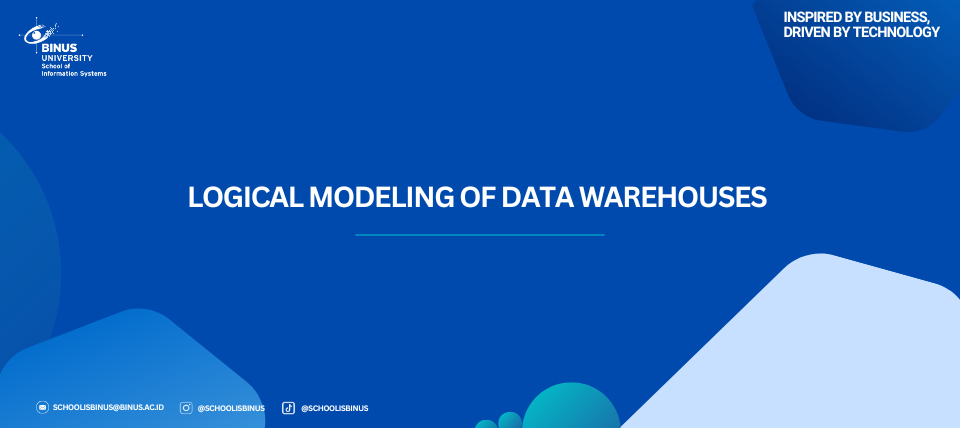Logical Modeling of Data Warehouses

Introduction
Logical modeling plays a crucial role in data warehouse (DW) design, acting as the bridge between the conceptual model—focused on business requirements—and the physical model—concerned with database implementation. According to Bhatia (2019), the logical model defines the data’s structure, relationships, and rules in a way that supports analytical processing and decision-making. It determines how business processes are represented through facts, dimensions, hierarchies, and attributes, ensuring that data is accurate, consistent, and ready for analytical use.
Purpose and Characteristics
The main purpose of a logical data warehouse model is to transform complex business requirements into a structured schema that facilitates efficient querying and reporting. It aims to:
- Represent analytical needs through well-defined dimensions and measures.
- Optimize Online Analytical Processing (OLAP) performance.
- Simplify data integration while maintaining flexibility for future changes.
Bhatia (2019) highlights that logical models define the granularity of facts, the structure of dimensions, and the historical tracking mechanisms, such as Slowly Changing Dimensions (SCDs) which directly affect the warehouse’s analytical accuracy.
Logical Modeling Approaches
Several modeling approaches are commonly used in modern DW environments:
- Dimensional Modeling: The most widely adopted approach, involving star, snowflake, and fact constellation schemas. It separates facts (quantitative data) from dimensions (descriptive attributes), making queries intuitive and efficient (Bhatia, 2019).
- Data Vault Modeling: A newer approach designed for auditability, scalability, and flexibility. It separates data into Hubs (business keys), Links (relationships), and Satellites (context and history). Helskyaho et al. (2024) introduced data model quality metrics to evaluate and improve Data Vault 2.0 designs.
- Multi-Model Data Warehousing: Emerging research, such as Bimonte et al. (2023), explores integrating multiple data models (relational, document, graph) to handle heterogeneous data and improve analytical performance in big data environments.
Logical Design Steps
Logical modeling typically involves the following steps:
- Business Process Identification : Define business processes, measures (facts), and descriptive contexts (dimensions).
- Grain Definition : Determine the lowest level of data detail (transaction, daily, or event-based).
- Schema Selection : Choose a suitable schema type based on business goals (e.g., star for simplicity, Data Vault for flexibility).
- Historization Rules : Establish how changes in dimension attributes are tracked over time (SCD types I, II, or III).
- ETL/ELT Alignment : Design the model to align with modern ELT pipelines, especially for big data systems.
Modern Challenges and Best Practices
Recent developments emphasize hybrid and adaptive design principles. Multi-model data warehouses offer flexibility to integrate structured and semi-structured data efficiently (Bimonte et al., 2023). The evaluation of model quality such as schema complexity, consistency, and auditability—has become an essential part of DW lifecycle management (Helskyaho et al., 2024).
Moreover, data engineers are shifting from traditional ETL (Extract, Transform, Load) to ELT (Extract, Load, Transform) processes, allowing transformations to occur inside scalable data lake or cloud-based environments (Dhaouadi et al., 2022). Logical models must therefore be adaptable, supporting distributed architectures and near-real-time analytics.
Conclusion
Logical modeling remains the backbone of successful data warehouse systems. It translates abstract business needs into analytical structures that support accurate, consistent, and high-performance querying. While Bhatia (2019) laid the foundational principles of logical modeling through dimensional and relational techniques, recent advancements such as Data Vault 2.0 and multi-model integration reflect the evolving landscape of big data and analytics. The best practice today is to combine traditional dimensional clarity with modern flexibility, creating a logical model that is both business-aligned and technically scalable.
References
Bhatia, P. (2019). Data Mining and Data Warehousing: Principles and Practical Techniques. Cambridge University Press.
Bimonte, S., Gallinucci, E., Marcel, P., & Rizzi, S. (2023). Logical design of multi-model data warehouses. Knowledge and Information Systems, 65, 1067–1103. https://doi.org/10.1007/s10115-022-01788-0
Dhaouadi, A., Bousselmi, K., Gammoudi, M. M., Monnet, S., & Hammoudi, S. (2022). Data warehousing process modeling from classical approaches to new trends: Main features and comparisons. Data, 7(8), 113. https://doi.org/10.3390/data7080113
Helskyaho, H., Ruotsalainen, L., & Männistö, T. (2024). Defining data model quality metrics for Data Vault 2.0 model evaluation. Inventions, 9(1), 21. https://doi.org/10.3390/inventions9010021
Turcan, G., & Peker, S. (2022). A multidimensional data warehouse design to combat the health pandemics. Journal of Data, Information and Management, 4(3–4), 371–386. https://doi.org/10.1007/s42488-022-00082-6

